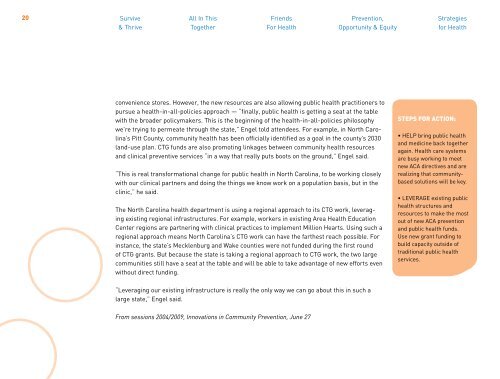INSIGHT & INSPIRATION FROM APHA’S 2012 MIDYEAR MEETING
INSIGHT & INSPIRATION FROM APHA’S 2012 MIDYEAR MEETING
INSIGHT & INSPIRATION FROM APHA’S 2012 MIDYEAR MEETING
Create successful ePaper yourself
Turn your PDF publications into a flip-book with our unique Google optimized e-Paper software.
20<br />
Survive All In This Friends Prevention, Strategies<br />
& Thrive Together For Health Opportunity & Equity for Health<br />
convenience stores. However, the new resources are also allowing public health practitioners to<br />
pursue a health-in-all-policies approach — “finally, public health is getting a seat at the table<br />
with the broader policymakers. This is the beginning of the health-in-all-policies philosophy<br />
we’re trying to permeate through the state,” Engel told attendees. For example, in North Carolina’s<br />
Pitt County, community health has been officially identified as a goal in the county’s 2030<br />
land-use plan. CTG funds are also promoting linkages between community health resources<br />
and clinical preventive services “in a way that really puts boots on the ground,” Engel said.<br />
“This is real transformational change for public health in North Carolina, to be working closely<br />
with our clinical partners and doing the things we know work on a population basis, but in the<br />
clinic,” he said.<br />
The North Carolina health department is using a regional approach to its CTG work, leveraging<br />
existing regional infrastructures. For example, workers in existing Area Health Education<br />
Center regions are partnering with clinical practices to implement Million Hearts. Using such a<br />
regional approach means North Carolina’s CTG work can have the farthest reach possible. For<br />
instance, the state’s Mecklenburg and Wake counties were not funded during the first round<br />
of CTG grants. But because the state is taking a regional approach to CTG work, the two large<br />
communities still have a seat at the table and will be able to take advantage of new efforts even<br />
without direct funding.<br />
“Leveraging our existing infrastructure is really the only way we can go about this in such a<br />
large state,” Engel said.<br />
From sessions 2004/2009, Innovations in Community Prevention, June 27<br />
STEPS FOR ACTION:<br />
• HELP bring public health<br />
and medicine back together<br />
again. Health care systems<br />
are busy working to meet<br />
new ACA directives and are<br />
realizing that communitybased<br />
solutions will be key.<br />
• LEVERAGE existing public<br />
health structures and<br />
resources to make the most<br />
out of new ACA prevention<br />
and public health funds.<br />
Use new grant funding to<br />
build capacity outside of<br />
traditional public health<br />
services.



